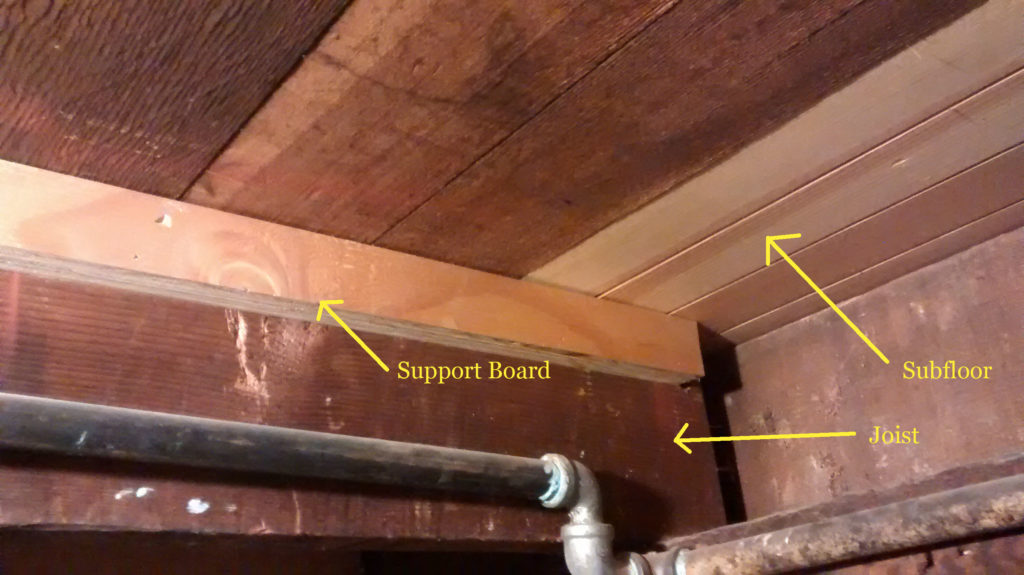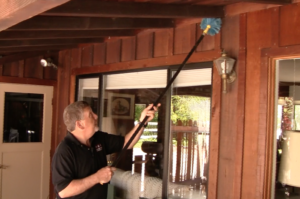
If you’re starting to think your house is haunted, you may just need to do some home maintenance. Photo: Olivia Bustos (2017)
It’s a dark night.
You’re in your living room, binge-watching the new season of “Stranger Things,” when you notice a shrill whistling sound coming from somewhere inside the house. You pause the show and get up to investigate.
Walking into the hall, you’re struck by a sudden chill in the air, which causes you to emit an involuntary shiver. You draw your arms inward and follow the whistling sound to your bedroom, but just as you open the door, it stops. You enter the still room and scan for any unusual signs.
Suddenly, the silence is broken by a loud creak directly behind you. You whip around to see the bedroom door closing by itself! Terrified, you lunge through the doorway, back into the hall. To your astonishment, the hallway lights are flickering wildly, casting frenetic shadows upon the walls. The whistling sound resumes, now punctuated by accompanying creaks and groans, together grating out a feverish cacophony. Covering your ears, you fall to your knees and scream aloud, “What do you want?!”
Scary, right?
Despite the spine-tingling nature of this scene, these happenings aren’t necessarily the work of sinister spirits. In fact, a more likely explanation is they were caused by a mere lapse in home maintenance. From creaky floors to swinging doors, malfunctioning components in your home can cause a lot of irritation and even the occasional scare. The good news is most of these issues are simple to fix if you know how. So, take off your ghost-busting gear and get out your toolbox—it’s time to de-haunt your house, one ghastly glitch at a time!
Swinging doors
If a door in your home swings open or closed, you may think the only solution is to completely remove and reset it. However, as Dennis Thompson of Thompson Construction explains, there’s a much simpler solution you can try. “First, remove a pin from one of the hinges by tapping it from below with a hammer. Place the pin on a piece of wood or another hardy surface and hit it with your hammer to create a slight bend in the middle. When you return the pin to its hinge, this should create enough resistance to keep the door from swinging. Depending on the extent of the problem, you may need to repeat this step with two or even all three pins.”
Drafty, noisy windows
When a window’s insulating components become worn out, it can produce cold drafts, as well as rattling and whistling noises on windy nights. For a short-term fix, there are several quick and easy options, such as v-seal weather stripping, shrink film and rope caulk, all of which can be purchased at your local hardware store. For a long-term solution, re-glaze older windows or, for newer windows, replace failed gaskets and/or weather stripping. In the case of older windows, sometimes the best solution is simply to have them replaced with newer, better-insulated models.
Squeaky floors
Floor squeaks can be caused by a couple of factors, like floorboards rubbing against each other or sliding against nails at points where the subfloor has separated from the floor joists. To address the former scenario, try lubricating the squeaky boards with powdered graphite or talcum powder. After applying the lubricating agent between the boards, put a cloth down and walk on the area to work it into the cracks.
If the squeak is being caused by a separation between the subfloor and a joist, your repair options will depend on what kind of access you have. If you have open access to the floor from below, go down and have someone walk over the squeaky area. Once you’ve located the source of the squeak, use one of the following repair methods:
- Apply some wood glue to a shim and slide it into the gap between the subfloor and joint until snug. Don’t force the shim in any further than needed—this could create further problems.
- Fasten a support board to the side of the joist. Make sure the top edge of the board is pressed up against the subfloor—this will keep the floor from sinking down when walked upon. Apply construction adhesive to the top edge and side of the board before affixing it to the joist with wood screws.
- Fill in lengthy gaps between the subfloor and joist by applying a liberal amount of construction adhesive.

One way to fix a squeaky floor is to attach a support board to the joist where it meets the subfloor. Photo: American Ratings Corporation (2017)
If you don’t have access to the floor from below, you’ll need to tackle the repair from above. Use a stud sensor to find the offending joist and insert a screw into the floor to refasten the separated area. For carpeted floors, use a utility knife to make a slit in the carpet and then peel it back before inserting your screw. For hardwood floors, one or two long finish nails will do the job with minimal aesthetic impact. You can also purchase a floor repair kit to streamline the process of above-floor repairs. Keep in mind that you may need to try a few different repair methods before you find one that stops the squeak once and for all.
Creaky doors
Typically, door creaks can be resolved by lubricating the hinges. A little WD-40® should do the trick—just open and close the door a few times to work it in. If your creaks return soon after, you may need to go a step further by removing the door entirely and coating the hinges with a lubricant such as white grease or cooking oil.
Flickering lights
Since flickering lights can stem from a number of factors, you’ll need to do some investigating to pin down the root cause. Sometimes it’s as simple as a bad bulb or a loose connection in your light fixture; other times, it can result from an incompatibility between bulb and fixture—for example, LED bulbs’ low resistance can cause issues with dimmer switches. If flickering occurs when large appliances are running, it may be due to an electrical circuit that’s being overloaded. Additionally, since your home shares a transformer with other nearby homes, there’s always the possibility that your issue is being caused by a neighbor’s heavy electrical usage.
In some cases, flickering lights can be a symptom of a dangerous condition. Loose wiring or worn-out connectors in your breaker box can pose a serious fire hazard, so if you’ve ruled out the more innocuous culprits in your investigation, don’t hesitate to call a licensed electrician for a more in-depth assessment of the situation.
Cobwebs

Regularly sweeping your home’s eaves will deter spiders from setting up their webs there. Photo: American Ratings Corporation (2017)
Even if you don’t have the kind of jumbo-sized cobwebs used for Halloween decorations, spiders and their webbing can still be a nuisance. David Osborn of Osborn Spray Service offers some helpful tips: “Since spiders tend to congregate in a home’s eaves, one effective measure is to regularly knock down their webs, which encourages them to ‘set up shop’ elsewhere. Once a week, go through your home and use a broom to brush away any visible webbing in the eaves or corners of windows. You can also do this outside along your home’s exterior.”
Another way to keep spiders out is to minimize their avenues for entry. “Trees, shrubs and hedges that come into contact with your house can be a catalyst for spiders to gain entry—not to mention insects and rodents,” says Mr. Osborn. “Inspect your home’s exterior from time to time and make sure all nearby branches and bushes are cut back a minimum of 18 inches.”
As you can see, it only takes a little time and effort to make your home a more pleasant (and less frightening) place to live. To find a Diamond Certified company that can help you with one or more of the problems we’ve covered, visit diamondcertified.info.
Happy Halloween!

Photo: Megan Harris (2017)
